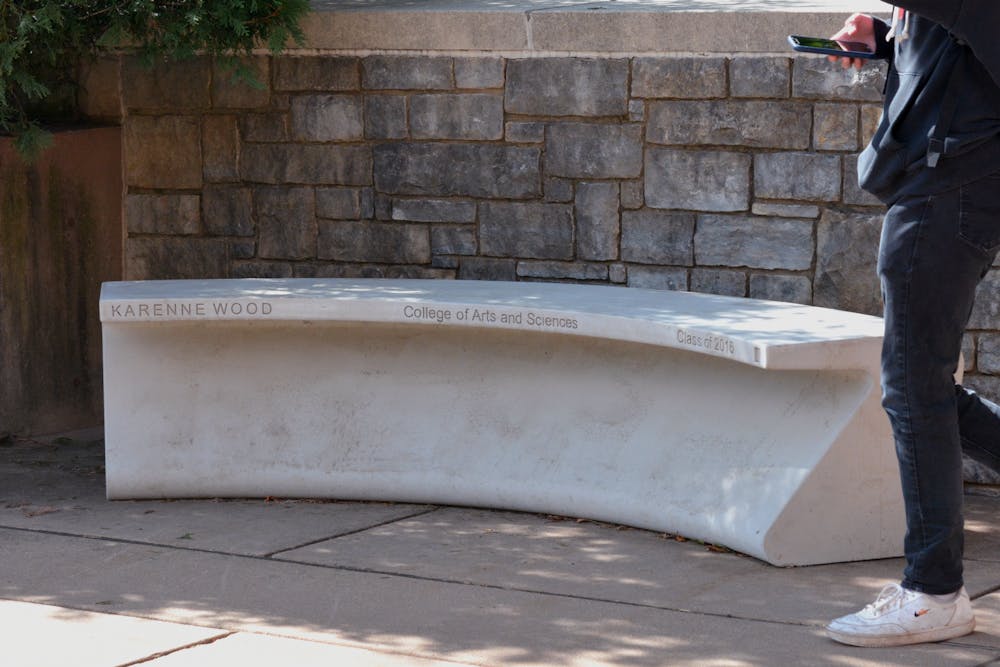Students crossing the bridge from Nau Hall to New Cabell or exploring the McIntire School of Commerce may stumble across one of six newly-installed memorial benches on Grounds. These simple, curved white pieces of concrete — engraved with the names of women and members of other marginalized groups deeply involved in the University — were recently installed as part of fourth-year Commerce student Sanjeev Kumar’s Memorial Benches Initiative.
Facilities Management installed six of the 1,100 pound outdoor benches this summer. Each bench features the name of an honoree and a QR code with links to more information about the individuals and the project itself.
The initiative was born during Kumar’s first year at the University, when he and Abigail Schofield, collaborator and fourth-year College student, noticed that the majority of artworks, monuments and other objects of recognition centered white men.
“Looking around, we saw statues of Thomas Jefferson, buildings of men,” Kumar said. “We didn't see women or people of color in the built environment, even though U.Va. prided itself on diversity within the student body.”
In the following two years, Kumar and Schofield contacted faculty members, wrote proposals, fundraised and ultimately came up with a plan — a bench dedicated to a graduate of each undergraduate school at the University.
Kumar also played a major role in the design of the benches. He chose concrete over other materials such as wood in order to maximize the longevity of the pieces, and opted for a curved design to encourage discussion and reflection.
“The nature of the benches is for people to sit down and to be able to face each other,” Kumar said. “There's no back to it, so it's kind of formless, to foster a sense of conversation around the people that use the bench.”
A bench located by New Cabell Hall honors Karene Wood, College alumna and director of Virginia Indian Programs. Woods was a member of the Monacan tribe — a group that originally inhabited the land that the University occupies today — and advocated on behalf of Native Americans in Virginia.
Another bench by Thornton Hall remembers Wesley Harris, Engineering alumnus and activist, to highlight his experience as the first Black student to enter the Jefferson Society, as well as his work with the Thomas Jefferson Council on Human Relations. During his time as an
Engineering undergraduate, Harris worked to coordinate Dr. Martin Luther King’s visit to the University in March 1963, months before King’s famous “I Have a Dream” speech.
Kumar also considered representation at the University’s College at Wise campus, where a bench honoring Sandra Jones, former staff member of 22 years and chair of the Black History Committee, was installed Sept. 17.
To coordinate locations of the benches, Kumar worked with Facilities Management members, including Director Mark Stanis. Stanis spoke highly of the Memorial Benches Initiative, and said witnessing initiatives like Kumar’s come to life is one of the reasons he’s enjoyed working at the University for 23 years now.
“I think it's invigorating to have young adults that are thinking about these things and will have the tenacity to really keep at it,” Stanis said.
Stanis also spoke to the bench’s contrast with the University’s typical architecture, a feature that he hopes will draw attention to the project’s purpose.
“Walking around Grounds people will see these benches now … and you're drawn to it because it's different,” Stanis said. “And then when you scan the QR code and read about the vision of the project, I think that's really helpful.”
Throughout the project, Abby Palko, director of the Maxine Platzer Lynn Women’s Center, served as an advisor, answering questions and providing feedback. Palko said that the project works to fulfill a gap in representation, and she admires Kumar’s community-based approach.
“[The project] speaks to what I hear students saying that they need visible markers that show everyone belongs here,” Palko said. “The other layer that I find so impressive is just how much work Kumar put into this and how he was able to seek guidance and take advice from folks all across Grounds.”
For his efforts with the Memorial Benches Initiative and beyond, Kumar was awarded the John Casteen Diversity Award honoring University leaders in diversity, equity and inclusion. Even following the project’s success, Kumar remains committed to inclusivity efforts. Together, he and Schofield founded She Writes History — a CIO dedicated to sharing women's narratives — as a sustainable continuation of the project’s goal to promote diversity, equity and inclusion of women and other marginalized communities. Schofield currently serves as the organization’s president.
Kumar hopes to use the knowledge from his experience with the benches to promote She Writes History and similar initiatives. He is also in the process of advocating for an Asian student center on Grounds, an effort that Palko said will solidify the bench’s impact.
“It's not just changing the built landscape to create these memorial benches so that there are markers that represent the full spectrum of the student body,” Palko said. “It's also concrete, the depth to advocate for the resources and the spaces that students need while they're here so that they can make the most of their time at U.Va. And they can walk away with the strongest education possible and then go on to change the world and make it a better place.”







